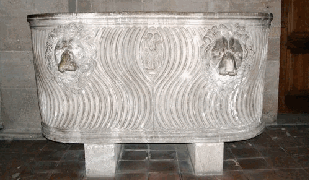|
Current status of the project: Since August 2022, this website has provided Burgundio's Preface and Homilies #1-48, transcribed from two manuscript witnesses that are freely provided online by the Biblioteca Apostolica Vaticana. The major source is MS Vat. lat. 383, a 12th-century manuscript that is probably the presentation copy Burgundio prepared for Pope Eugenius, who commissioned that translation; unfortunately, a folio page containing the preface and the first 466 words of Homily 1 was excised from this manuscript. The missing portion has been supplied by employing a 15th-century witness, MS Vat. lat. 384, which was very likely copied directly from MS Vat. Lat. 383 prior to the loss of the first page. The latter manuscript has also been consulted to resolve occasional legibility problems in the earlier copy. I discuss the relationship between these manuscripts in a video "lightning talk" presented in November 2021 for the Schoenberg Symposium on Manuscript Studies in the Digital Age, U. Pennsylvania: "Loss and recovery in the manuscripts for the CLIMO Project" (archived on YouTube).
Related materials are provided on the Auxiliary Resources page of my Electronic Manipulus florum Project website, including transcriptions of Anianus of Celeda's 6th-century translation of the first 25 homilies of Chrysostom's homilies on Matthew from the 1503 Opera omnia Chrysostomi (Venice), the first 8 homilies from Anianus' translation from Migne's Patrologia Graeca 58, and the Pseudo-Chrysostom Opus imperfectum in Mattheum from PG 56.
Finally, here is a link to a page on my Digital Liber pharetrae Project for eight quotations from Burgundio's translation of Chrysostom's homilies on Matthew that I have found appear in that florilegium (so far), and a page on this website for the fifteen quotations from this text I have found (so far) in Manipulus florum.
An application for major funding was submitted in October 2024 to support a collaborative research program that would include the completion of the CLIMO Project by Spring 2028. This resource will provide full transcriptions of Burgundio's 12th-century translation, the 5th-century translation of Anianus of Celeda (homilies 1-25) and the 15th-century translation of George of Trebizond (homilies 26-90) from MS Vat. lat. 385 (c. 1450), and the 18th-century translation of Bernard de Montfaucon, as well as Montfaucon's critical edition of the original Greek text. These texts will be provided in parallel columns to facilitate synoptic analysis, following the model of the CLIO Project, which I completed in June 2022.
|
|


